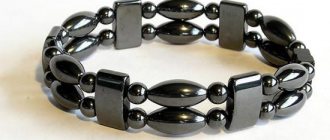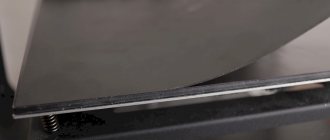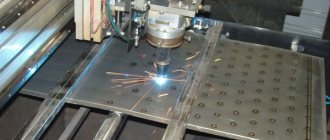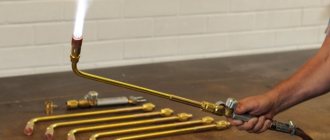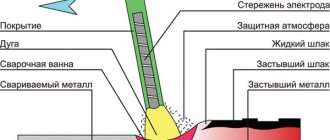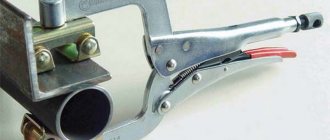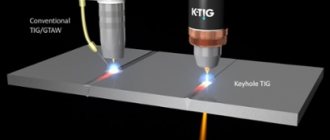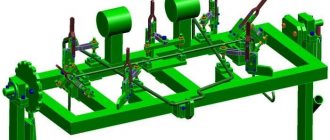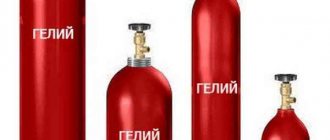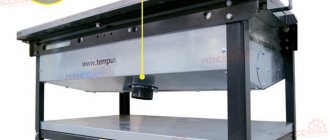Types of fasteners and their purpose
In order for the weld to be strong and reliable, the workpieces to be welded must be fixed. For this purpose, there are many different types of equipment, universal and specialized. These include:
- switchable magnets for welding;
- screw clamps;
- screw spacers;
- magnetic corners.
Switchable magnets
In this type of equipment, it is possible to control the intensity of the magnetic field, turning it on and off. This effect is achieved by rotating one magnet inside the housing relative to the other so that their magnetic fields either mutually enhance or neutralize each other, and the field does not pass beyond the housing. Switchable magnets are placed and removed from workpieces with one finger movement. Such devices are especially convenient when it is necessary to correct the position of workpieces. Another advantage is that after turning off such a holder, all sawdust, trimmings, shavings and other small metal waste fall off it, making cleaning easier
Switchable magnet
Clamps
The equipment is designed to reliably press the workpieces against each other. Its outer part, made in the shape of a right (or other) angle with a cut out top, is the fixing part, and the inner part, equipped with a screw feed device, is a clamping device. Essentially, this is a vice with jaws bent at an angle. The parts (profile or rod) are placed in a clamp and pressed against each other with a screw.
The dimensions and shape of the parts are limited by the size of the clamp. It can be used not only for welding, but for other plumbing work.
Clamp
Spacers
Spacers are used to create the required gap between the workpieces to be welded. Home craftsmen choose for this purpose cutting pipes and profiles from a waste box, but it is much more convenient to use an industrial product. The spacer is also equipped with a screw and is a “reverse clamp”. It can be adjusted to any required clearance within the screw stroke. Spacers and welding magnets are often used together.
Magnetic corners
One of the most commonly used devices is a corner. Its main advantages:
- Reduces the labor intensity of the welding process. The time for fixing workpieces is reduced several times.
- Parts can be fixed at almost any angle between them.
- The device is compact and does not interfere with welding work.
- The time for removing equipment is also reduced several times compared to clamps.
Magnetic corner
Magnetic corners are available with both fixed angles and freely variable angles. To do this, they are equipped with a hinged device with a lock.
Structurally, the equipment consists of two metal plates cut from sheet metal and permanent magnets fixed between them. The most popular are universal flat corners, reminiscent of a house with a cut off roof. But there are also three-coordinate spatial clamps in the form of polyhedra or cylinders. They allow you to assemble very complex spatial structures, such as power line supports, spatial trusses, etc.
Purposes of use
The main goals pursued by the use of magnetic holders for welding work are the following:
- convenient and reliable fixation of workpieces;
- placing them in space in strict accordance with the product drawings;
- precise alignment of angles between parts;
- reducing the labor intensity of welding and improving its quality;
- replacement of obsolete screw clamps and clamps.
Magnetic corners for welding have a clamping force from 5 to 60 kg and are used with sheet metal and rolled profiles.
How to choose a magnetic angle for welding?
For simple amateur work, inexpensive standard designs of magnetic holders are quite suitable, but for complex professional work and production conditions, three-coordinate (when using cylinders) and tetrahedral squares are intended - made using ferritic heat-resistant magnets, they will provide the necessary power for confident fixation of a wide variety of weights and configurations of elements of the welded structure.
In any case, a high-quality magnetic angle for welding must be designed for heavy loads, have high tensile strength and be resistant to strong mechanical influences from the outside. A square with a certain power must firmly fix the structural elements corresponding to this power in weight and size - only in this case will the welder’s work be comfortable and safe.
To facilitate the dismantling of the magnetic fixing device, it is recommended to choose angles with switchable welding magnets - in this case, even one master can easily and quickly cope with complex work using a special switch (one or two to turn each edge on/off). Switchable corners are usually made from durable chrome plated sheets, and thanks to the working edges they are successfully used in working with various profiles.
Thus, it is recommended to choose a magnetic holder for welding work based on the expected joint angles of the parts, the weight of the tool, its size and power.
Characteristics of welding magnets
According to the degree of versatility, equipment is divided into two types:
- universal;
- corner magnets.
Universal equipment has one or more degrees of adjustment and allows you to work with workpieces of flat, cylindrical and multifaceted shapes, connecting them at arbitrary angles in several planes simultaneously. Such devices are indispensable when assembling complex spatial structures. They are given increased resistance to heat and splashes of molten metal.
These advantages of professional-grade equipment come at the price of a high price and limited availability in regular hardware stores.
The square is much simpler in design, easier to learn and allows you to cover most of the needs of the home craftsman.
Triangular Welding Magnets
Hexagon welding magnet
Angles are available in three main forms:
- sagittal (“house”);
- triangular;
- hexagonal.
Arrow-shaped and triangular ones allow you to weld workpieces at angles of 45°, 90° and 135°. Hexagonal, in addition, support angles of 30°, 60°, 75°.
Using magnetic squares when working with simple structures saves even more time than using universal ones. The disadvantage of such devices, especially their budget models, is the low magnetic force.
Classification of magnetic squares
Since the range of tasks that a welder’s magnetic angle
quite wide, many variants of this useful device have been developed. They differ in shape. Different shapes allow different angles to be set. There are differences in design and principle of operation.
First of all, it is worth saying that the square can be factory-made or home-made. The advantages of a factory square are obvious - you can simply buy it in a store, the angles on them are precisely adjusted, and it is easy to use. But usually factory squares are made in such a way that they allow you to set a specific angle, for example 90º or 25º. A homemade square can be made to set any angle.
According to the principle of action, they are distinguished:
- Simple squares. They allow you to set only certain angles.
- Magnetic clamps. They have an adjustment mechanism. With it you can set almost any angle. Therefore, such a tool is much more versatile to use.
- Magnetic square with switchable fixation. This type of square is equipped with switches that allow you to turn off the magnetic fixation. Therefore, such a square can be easily removed after finishing work - just flip the switch and remove the device, and not tear off a powerful magnet from the metal with brute force, as with previous types.
The power of the magnets used in the design of the angles also varies. The heavier the parts you have to hold, the more powerful the squares you need. For small welding work at home, a low-power magnet will be sufficient.
Advantages of magnets
The main advantages of magnets compared to screw and wedge equipment are:
- Easy and quick rough assembly of the structure.
- Possibility of fixing parts at the most common angles of 45°, 90°, 135°. Advanced models of magnetic fasteners for welding will allow you to fasten workpieces at angles of 30°, 60°, 75°, and universal ones - at any angle.
- Saving time on preparatory operations several times.
- The fasteners are small in size and do not interfere with welding.
- Switchable welding magnets make it easier to install or remove.
- Easy to clean from shavings, sawdust and slag. (especially switchable ones).
The disadvantage compared to screw and wedge fastenings is their inapplicability to wood, plastic and other non-magnetic materials.
Criterias of choice
Before you start buying a magnet for welding, you should think about what specific operations you are going to use it for. In addition, the volume of this work and its frequency are important. If you need to weld the frame of a fence or greenhouse once a year, or replace the trim of a trailer body for a walk-behind tractor, there is no point in buying a professional model with fixation at an arbitrary angle in three planes, but you can get by with a couple of squares.
If you are opening a business and the scope of welding for six months to a year is clear, then a professional device will pay for itself by increasing labor productivity.
There are also several general rules and recommendations for selection:
- The higher the class of equipment (and its price), the longer it will retain its working qualities, primarily its geometric dimensions and clamping force.
- High magnetic field power allows you to hold workpieces of greater mass or length. Mid-level models hold up to 35 kg.
- A larger number of angles will allow welding of a variety of structures.
Modern high-quality devices do not have a negative impact on the stability of the welding arc. Unfortunately, some cheap Chinese holders have this effect on welding quality and are best avoided.
Switchable magnets are several times more expensive than permanent ones. But they are also much more convenient.
It becomes possible to weld without an assistant. With them, it is possible to precisely adjust the position of parts with millimeter precision - just turn off the magnet for a second and move the workpiece. It is also much easier to remove them from the finished product after welding. Another advantage is that when the magnet is turned off, all the iron debris stuck to it falls off on its own. Whether such convenience and performance is worth the money requested is something everyone decides for themselves.
The quality of the switched-off magnet must be high. If it switches off spontaneously during welding, the structure may disintegrate into blanks and the work will have to be redone.
A simple DIY magnetic square
The magnetic square has a very simple structure and is quite accessible for self-production by a craftsman with metalworking skills. Usually they are made by hand in three cases:
- testing your strengths and abilities;
- There is no suitable size on sale;
- for welding non-standard products.
Do-it-yourself magnet for welding
For production you will need:
- sheet metal 2-3 millimeters thick;
- round magnet (from an old speaker);
- bushings made of non-magnetic material (plastic, hard rubber, etc.);
- nuts, countersunk head screws.
The manufacturing sequence is as follows:
- Draw the outlines of the holder on the sheet. You need to be especially careful and use only a high-quality and certified square and ruler for marking. The accuracy of the assembly of your future structures will depend on the accuracy of the angles when marking.
- Using a grinder or jigsaw, cut out the parts and align their edges.
- Cut the bushings to size. It is important that they are strictly the same in height and have smooth edges.
- Pick up a piece of elastic plastic and fix the magnet along its inner hole.
- Mark the places for fastening, drill the plates (preferably together).
- Assemble the product by putting the bushings on the screws and placing them and the magnet between the plates.
The clamping force of the product depends on the accuracy of the assembly and the magnetic properties of the metal; before welding, it will have to be determined experimentally.
Magnetic angles for DIY welding
These tools are designed to hold metal parts and pipes during the welding process, soldering and assembling products. An experienced craftsman will no doubt find use for this useful part in other areas of the economy.
Magnets for welding: advantages of use
- They are used when working with round and rectangular pipes, metal sheets, and non-standard shaped parts.
- The welding angle can be of standard sizes, for example, 30, 45, 60, 90, 135 degrees. Also, a magnetic corner for welding can be universal and be adjusted to any required angle.
- On-the-fly fastening: The magnetic welding holder is fixed to the part independently.
- The ability to work without the help of a partner, that is, labor costs are reduced to a minimum. This factor is especially important if there is a large amount of welding work to be performed.
- Angles can be used in any location of the parts to be welded and at any angle.
- Magnetic holders can also be used to mark any elements.
Currently, for an increasing number of welders, magnetic angles have moved from the category of auxiliary tools to the category of necessary ones.
What types of fixing angles are divided into?
Division into types can occur for various reasons. According to the source of their occurrence, they can be divided into factory corners and homemade ones. Of course, for professional use it is better to purchase angles from well-known manufacturers. For one-time uses on the farm, it is better to use a homemade magnetic holder, which is much cheaper.
You can make a magnetic square for welding from steel by first drawing drawings. The plates can be hand poured or laser cut. There should be a spacer between the plates that prevents the sticking of metal filings and gives the product more rigidity. It can be made, for example, from plywood. Aluminum rivets and glue are used to assemble all the elements together. As a result, we get a magnet for welding with our own hands. If everything is done correctly, it will be similar to the factory counterparts.
Magnets are also divided into types depending on the configuration and principle of operation:
- The conventional holder design allows for a fixed angle setting.
- The magnetic clamp is characterized by the ability to adjust any angle, which allows it to be used for work of any complexity.
- The clamp can have a permanent and switchable magnet for welding. The last view is automatically switched off after welding is completed. That is, you don’t need to make any effort to remove it.
- Most modern clamps have multiple angle settings, making them applicable to a wider range of welding applications.
- Corners come in different capacities. To fix bulky, large and heavy parts, you need to use more powerful magnets, and light elements are welded using low-power magnets.
Thus, the importance of using magnetic corners for fixing products is very high. They simplify the work and allow you to do it more quickly, without the help of a partner. There are many manufacturers of magnets in different price ranges. It is important that the simple design allows you to make a magnetic square with your own hands, thereby minimizing material and labor costs during the work process. All of the above facts speak only about the positive qualities of this auxiliary material.
Read also: Ore mineral from which copper is extracted
Small metal objects are difficult to hold in one position during the welding process. Fixation is carried out using improvised means so that the products do not move. A magnetic corner is suitable as an auxiliary tool.
It is also called a welding square. It will be useful for both the home craftsman and the professional welder. This mechanism improves the quality of the weld and the part as a whole. Let's look at how to make a magnetic corner for welding with your own hands.
Types of magnetic holders for welding
A magnetic square is a mechanism for clamping one part or joining two parts, providing support in a given position during welding. It is suitable for single procedure and batch production. The devices differ in design and operating features. There are the following welding magnets:
- standard square with non-switchable magnet and stationary angles;
- clamp - a flexible device with the ability to adjust angles, suitable for products of varying complexity;
- holders with different powers - used to hold workpieces with different characteristics: for small ones - low power, for large ones - high power;
- switchable models - after switching off, the holders detach themselves, the element is released without effort;
- universal angles – equipped with several angles with frequently used parameters for performing complex and simple work;
- three-coordinate and quadrilateral devices - suitable for welding in difficult high-temperature conditions, they use ferrite magnets that can withstand temperature changes and cylinders.
For home use, you can assemble a magnetic corner for welding with your own hands. Handicraft tools can withstand mechanical loads. It can fix large parts, permanently hold and join parts of products to obtain high-quality seams.
Angular: permanent
Corner models consist of two plates with a magnet placed between them. These are multi-position devices with an adjustable clamping angle in the range of 30⁰-135⁰. They are suitable for quickly fixing elements to be welded. The plates allow you to hold an object in one of 6 positions. Such mechanisms are acquired when, during the welding process, the workpiece needs to be rotated from several angles.
- Important! Devices with fixed angles should be selected in situations where welding is carried out in frequently used positions
Disabled
Switchable models are devices with a magnetic field that is switched off with a special rotary lever. They make it easier to clamp and release the item being welded. Such devices are easily cleaned of metal shavings and small items.
Main selection criteria
For professional work, you should choose a high quality tool. Devices are exposed to high temperatures, which reduce the magnetization coefficient of low-quality specimens. The fixture must be free of chips, gouges and other defects where it touches the clamped product. Irregularities do not allow objects to be firmly fixed at a given angle.
- Important! The advantage of switchable corners is the ability to turn off the magnetic field both on the entire device and on its individual faces. These devices are suitable for craftsmen who often weld parts of complex configurations
Chinese angles have a budget price, but they cannot withstand temperature changes, so they quickly break. To weld products at different angles, it is recommended to choose a customizable mechanism or purchase a kit containing several types of tools for clamping at certain angles.
Homemade magnetic corner
Home craftsmen will be able to assemble a magnetic corner for welding with their own hands. To make it, you do not need highly specialized knowledge. You must first prepare:
- magnet – thickness less than 15 mm;
- steel sheet 2-3 mm thick;
- M6 bolts with a set of nuts or rivets;
- Important! The magnet configuration does not matter. Practice shows that it is better to choose a round shape. An option from a powerful speaker is suitable
Read also: Bosch 18 volt screwdriver circuit
The sheet of steel is marked in the shape of a triangle for subsequent cutting of the elements of the magnetic corner for welding with your own hands; it is better to take ready-made drawings. Use a grinder to cut out the first element according to the markings. The second part can be marked along the first by attaching it to the steel sheet. Using a file, clean the cut surfaces to a perfectly smooth state. Finished elements must be identical, errors are not allowed.
Magnetic holder for DIY welding
This is another design option for a magnetic corner for DIY assembly. It will require:
- metal sheet 1-3 mm;
- neodymium magnets (so-called “screw magnets”);
- dry board;
- nuts, countersunk head screws, self-tapping screws.
Manufacturing of magnetic holders for welding
The manufacturing procedure is as follows:
- Mark and cut two identical blanks from the sheet, carefully monitoring the accuracy of the angles.
- Make the central part of the holder. Cut it out of the board so that it follows the contours of the metal plates, but recedes inward to the height of the magnets plus a millimeter to one and a half.
- Fasten the metal and wooden parts of the product together.
- Using self-tapping screws, screw the magnets to the wooden spacer around the perimeter so that they are at the same distance from each other.
Before starting work, you need to check the geometry of the resulting equipment - its angles and dimensions.
Magnetic square for DIY welding
Often, skill alone is not enough to carry out high-quality welding work, which is why various auxiliary devices are used, such as a magnetic corner. It is designed for fixing metal parts during welding, soldering or assembling structures, and a good owner will find a dozen more uses for this design.
What are the benefits of magnetic squares?
- Allows you to work with round pipes, rectangular cross-section, sheet metal and products of complex shapes;
- A good fixture has a number of standard angles - 45, 90, 135, 30 and 60 degrees; there are also universal models that can hold parts at any angle;
- Quick fastening, unlike clamps, just lean the corner against the parts and it will fix itself;
- Simplification of the welding process occurs due to the absence of the need to use an assistant for the welder, plus the ability to adjust the location of the parts to be welded after they are secured;
- The device can work in any planes, at any angle and on any surfaces;
- Preset template angles make it easier to work with in-line products.
It is also worth noting that for most welding work, such a part is not just a recommendation, but an integral part of the work process.
How to choose the right model
The first step is to decide how you will use the holder. If you need it for one-time use, then the cheapest option is suitable, which will be useful in the future, but will not hurt your pocket.
For those who regularly work with welding equipment, models with a large number of preset angles and inexpensive universal models that allow you to independently set and fix the angle are suitable.
For professional use or to complete a small workshop, it is worth purchasing a set of magnets with a high degree of retention. Very often, one magnet is not enough to work with, so having a whole, even minimal, set will greatly facilitate the welder’s work.
The next parameter is the holding force. The stronger the magnet, the heavier the parts can be used in the work, the longer it will retain its holding properties and the better it will fix the parts. When buying magnetic welding devices with a high-quality magnet, make sure that you can remove it yourself, or better yet, that it has the ability to “unstick” on its own, that is, it is switchable.
Magnet quality is a parameter that most young welders forget about. Here it is important for us that the magnet can retain its properties for a long time and, more importantly, does not deteriorate when heated. The operation of a welding magnet occurs in close proximity to the welding site, so the entire product is subject to heating, which deteriorates the quality of the magnets.
A simple DIY magnetic square
Since this device is quite simple, you can easily make it yourself. This option is suitable for those who like to make things on their own, have not found the desired product on sale, or for cases when it is necessary to obtain fasteners for a non-standard template.
Design options may vary; here we will look at two manufacturing methods. The choice depends on your manufacturing capabilities and the availability of the necessary materials and tools. We recommend! Do-it-yourself resistance welding from a microwave
In the first case we will need:
- Metal sheet 2-3 mm thick. It is very important to use non-magnetic materials so as not to weaken the magnetic field;
- Round magnet (this can be found in acoustic speakers);
- Bushings;
- Fasteners (screws and nuts).
Manufacturing algorithm:
1. Using a triangle, draw the outline of the future product on a sheet of metal. Try to make the angles as straight as possible; the quality and accuracy of the finished tool will depend on this.
2. Using a grinder, we cut out our blanks and make smooth edges.
3. Prepare plastic bushings (remember that the material must be non-magnetic). You can take pieces of polypropylene pipe. We carefully process the ends, the dimensions of the bushings must be the same. To prevent the magnet from dangling, we select a piece of plastic and securely fix it in the inner diameter.
4. We mark the attachment points of the two plates and assemble them using bolts and nuts.
5. Finished product in progress
Magnetic holder for DIY welding
We will need:
- Sheet metal (1-3 mm);
- Magnets;
- Dry board;
- Fasteners
First of all, it is worth understanding the diagram of the future product. To begin with, it is better to use monolithic structures. Templates can be found on the Internet or you can create one for your own needs. We attach the template to the sheet metal and cut out two identical blanks. At the same time, it is very important to preserve their geometry.
Aluminum sheet blanks
The next step is to prepare the central part of the magnet. To do this, we cut out a piece of wood in the shape of the metal plates, but do not completely repeat the size, but step back from the edges so much that after assembly the magnet is buried between the steel plates by a couple of millimeters. Its thickness should be 1-2 mm greater than the width of the magnets.
Cutting out a template from wood
The outer part of the product is ready, now you need to make the inside. Here you should start from magnets. We will place them between the plates so that the thickness is in the range of 10 - 50 mm. It is best to use round magnets with a hole inside, called “magnets for self-tapping screws,” but others are also suitable for the job, which should be pre-processed and holes prepared for fastening.
We fasten the magnets using self-tapping screws
The last stage is drilling holes and assembly. First of all, we attach steel plates on both sides of the wooden workpiece, and attach magnets to the grooves. The product is ready - you can test our magnetic welding angle.
Checking magnet geometry
Source: https://svarkagid.ru/sdelaj-sam/oborudovanie/magnitnye-ugolki-dlya-svarki.html
How to make a switchable magnetic square
The cost of magnets for welding ranges from hundreds of rubles (household models made in China) to tens of thousands (switchable universal professional devices from well-known brands with the ability to work in many planes and arbitrarily set angles). But it is possible to make their analogue yourself:
- Cut two triangular-shaped plates from a sheet of metal (or in the shape of a house with a cut off roof). You need to carefully monitor the exact alignment of the angles.
- File the edges.
- The magnet can be used from faulty speakers or a microwave oven.
- Mark and drill through holes in the corners of the triangle and in its center.
- Using four screws and nuts and bushings equal in height to the magnet, fasten the structure so that the magnet is clamped in the center.
- To reduce contamination, plastic plugs can be placed along the end faces.
DIY switchable magnet
The shape of the magnet for welding may not be triangular. It is selected depending on the needs of the assembled welded structure.
Which magnetic squares are better?
Before answering this question, decide which parts you are going to weld and under what conditions. If you need to connect heavy elements during in-line, large-scale production, a model with powerful magnets and fixed angles is suitable. And if you are planning minor repairs or are going to use welding to assemble complex compositions (for example, welding shaped fences), a magnetic clamp with small magnets is better suited.
Correctly assess the complexity of the work. Maybe we can get by with inexpensive standard mold holders? But if the configuration of the future product is complex, you will have to splurge on a professional three-axis welding angle.
